Home | Surgeries | TECA-Bo Surgery in Dogs and Cats
TECA-Bo Surgery in Dogs and Cats
Total Ear Canal Ablation & Bulla Osteotomy (TECA-BO) in Dogs and Cats
Total Ear Canal Ablation (TECA) with Lateral Bulla Osteotomy (LBO), collectively referred to as TECA-BO, is a surgical procedure used to manage severe, end-stage ear disease in dogs and cats. It involves the complete removal of the ear canal and cleaning of the tympanic bulla, leaving only the ear flap (pinna) intact. TECA-BO is typically performed when other forms of treatment have failed, especially in cases of irreversible damage from long-standing ear infections, tumors, or trauma. While often performed by a board-certified specialist, general practitioners with surgical experience may also offer this procedure.
At Canton Animal Hospital, we perform Total Ear Canal Ablation with Bulla Osteotomy (TECA-BO) as a definitive solution for dogs and cats suffering from severe or chronic ear diseases that are unresponsive to medical treatment. TECA-BO is a surgical procedure that involves the complete removal of the external ear canal, followed by the cleaning and debridement of the middle ear (bulla). This procedure is typically indicated when long-term inflammation, infection, or neoplastic (tumor) conditions have caused irreversible damage to the ear canal and middle ear structures.
TECA-BO is not a first-line treatment—it is usually reserved for patients whose quality of life has been compromised by chronic pain, infection, and hearing loss. The goal of this surgery is to eliminate the source of infection and inflammation, relieve pain, and dramatically improve the pet’s quality of life.
Featured Resources

We Welcome New Patients!
We're always happy to give your furry friend care at our hospital. Get in touch today!
Contact Us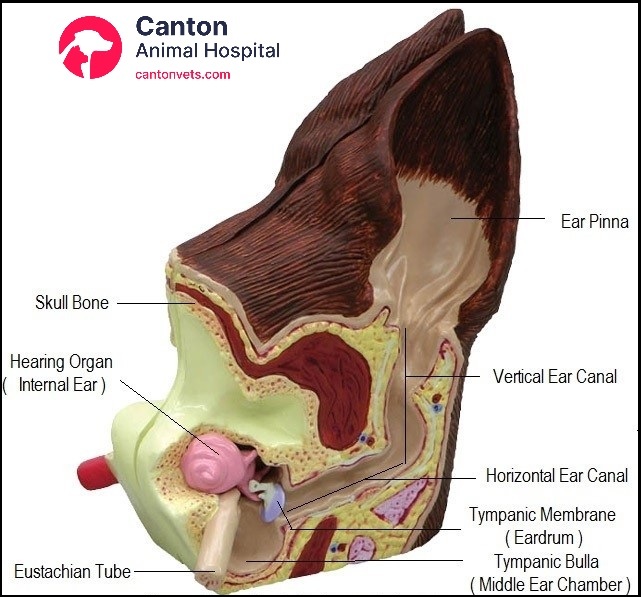
Conditions That May Require TECA-BO Surgery
TECA-BO may be recommended for dogs and cats suffering from:
Chronic otitis externa and otitis media – Long-standing outer and middle ear infections that are no longer responsive to medications.
Ear canal tumors or polyps – Benign or malignant growths obstructing or destroying the canal.
Severe canal fibrosis or mineralization – Scar tissue or calcification that causes narrowing or closure of the canal.
Traumatic injury to the ear canal – Severe damage due to accidents or bites.
Persistent drainage or head-shaking – Signs of ongoing discomfort despite medical management.
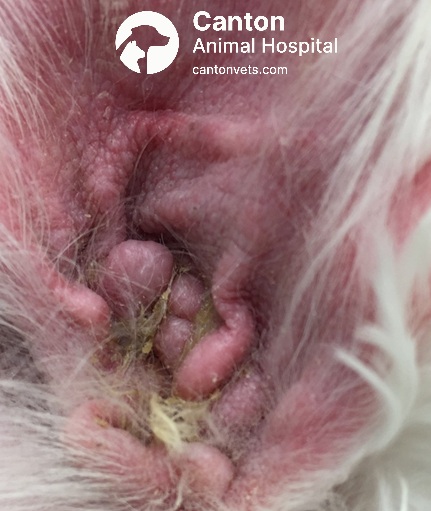
When to Consider TECA-BO
TECA-BO surgery is typically considered after all reasonable medical treatments have failed. It is appropriate when:
There is irreversible structural damage to the ear canal.
The pet suffers from frequent, painful flare-ups and infections.
Diagnostic imaging (CT or X-ray) reveals significant bony changes or soft tissue masses.
The pet's behavior and comfort level have been significantly affected—e.g., head tilting, scratching, whining, aggression, or depression due to chronic pain.
Owners often find their pets significantly more comfortable and happier post-surgery—even if some hearing loss occurs—because the pain and inflammation are finally resolved.
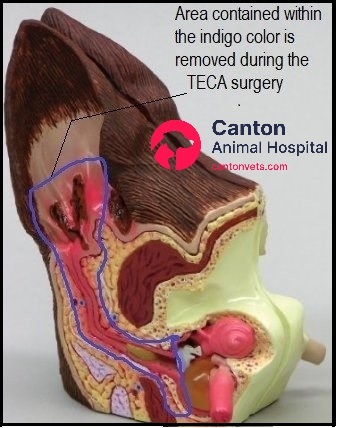
What Happens During the TECA-BO Procedure
Type of Anesthesia
TECA-BO is performed under general anesthesia to ensure complete unconsciousness, muscle relaxation, and pain control. The anesthesia protocol typically includes:
A pre-anesthetic sedative and analgesic to help your pet relax.
A brief IV anesthetic to allow the placement of a breathing tube.
Inhaled (gas) anesthesia in oxygen for maintenance during surgery.
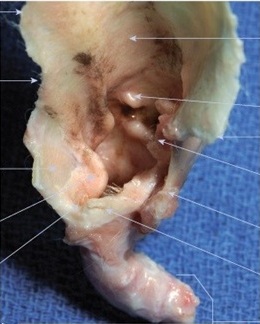
Surgical Procedure
The surgical process consists of:
Total Ear Canal Ablation (TECA): Complete removal of the vertical and horizontal ear canal. The external ear flap (pinna) is left intact.
Lateral Bulla Osteotomy (LBO): Removal of part of the bony wall of the tympanic bulla to allow thorough cleaning of the middle ear. This step is critical to remove chronic infection and debris, especially in dogs with ruptured ear drums—seen in approximately 50% of chronic cases.
Drain Placement (if needed): In about 2% of cases with severe infection, surgical drains are inserted. These helps flush the area and manage fluid buildup. Antiseptic flushes may be administered through the drains, and bandages may require daily changes for 6–7 days.
The procedure is performed by a skilled surgeon using sterile techniques. An Elizabethan collar is applied post-surgery to prevent trauma to the surgical site.
Hearing and Outcome Expectations
Will My Dog Still Be Able to Hear After the Procedure?
The inner hearing organ is not removed during TECA-BO surgery; however, removal of the ear canal often results in reduced hearing sensitivity—similar to wearing ear plugs or being under water.
Most pets undergoing TECA already have significant hearing loss due to chronic infections, so post-surgical hearing changes are usually minimal or unnoticeable to pet owners.
If bilateral TECA surgeries are required, more significant hearing loss may occur, though pets typically adapt well to the change.
What Is the Success Rate of TECA-BO Surgery?
When performed by an experienced surgeon, over 90% of pet owners report major improvements in their pet’s comfort, behavior, and quality of life.
Due to the delicate nature of this surgery, surgeon experience is key to minimizing complications and achieving long-term success.
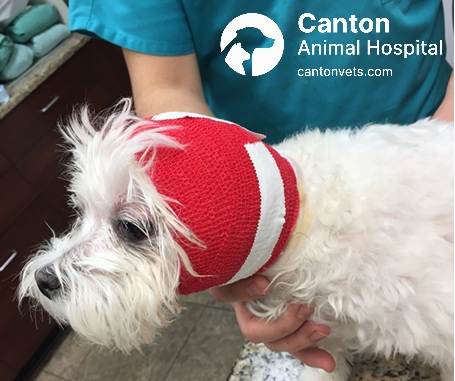
Post-Operative Recovery & Care
After TECA-BO surgery, your pet will require dedicated care for optimal recovery:
Hospital stay is usually 24 hours, provided recovery is uncomplicated. Your pet will be monitored for comfort, pain control, and any signs of post-operative complications before discharge.
Home medications typically include antibiotics, anti-inflammatory drugs, and pain relief.
Elizabethan collar (E-collar) is worn for 10–14 days to protect the incision and prevent self-trauma.
Incision monitoring at home to check for swelling, discharge, or discomfort.
Suture removal typically scheduled at 10–14 days.
Most pets begin showing signs of relief from chronic symptoms within a few days, with full healing over several weeks.
Prognosis
Prognosis is very good following successful TECA-BO surgery, especially when performed by an experienced veterinary surgeon.
Most pets experience significant relief from pain, infection, and behavioral changes associated with chronic ear disease.
Benefits of TECA-BO Surgery
TECA-BO provides life-changing benefits for pets suffering from chronic ear conditions:
Eliminates source of infection permanently, reducing or eliminating the need for antibiotics.
Removes pain caused by inflamed or damaged tissue.
Reduces discharge, odor, and scratching, improving hygiene and comfort.
Improves quality of life, allowing pets to be more active, social, and pain-free.
Behavioral improvement often occurs as chronic pain is resolved.
Potential Risks and Complications
As with any surgery, TECA-BO carries potential risks and complications. While the overall risk is low, it’s essential to be informed:
Anesthesia risks – As with any major procedure, there is a small risk of anesthetic complications. With modern monitoring equipment (EKG, pulse oximetry, blood pressure monitoring), these risks are minimized.
Bleeding – Several important blood vessels are located near the surgical site. While significant bleeding is uncommon, an experienced surgeon takes care to manage this risk effectively.
Postoperative infection or wound dehiscence – Incision breakdown or infection can occur but is uncommon with proper aftercare and surgical technique.
Facial nerve paralysis – The most common complication, affecting 5–10% of cases. This may cause drooping of the lips or inability to blink on the affected side. In most cases, this is temporary and resolves within 2 months. Eye lubrication may be required until normal function returns.
Pain when opening the mouth – This may result from inflammation in the nearby jaw joint but usually resolves within two weeks.
Horner’s syndrome – Rare. Caused by damage to nerves near the middle ear, it results in a constricted pupil or third eyelid elevation. More common in cats than dogs.
Vestibular dysfunction (balance problems) – Occurs in fewer than 2% of cases but may be seen if the inner ear is affected.
Throat swelling – Rarely, fluid accumulation can cause swelling that interferes with breathing. This complication occurs in about 5% of cases and requires immediate attention.
Recurrent infection – Though rare, untreated middle ear infections or ascending infections from the auditory tube may lead to recurrence and require a second surgery, such as a ventral bulla osteotomy.
Changes to the pinna (ear flap) – In some cases, the ear may droop or appear differently after surgery due to changes in structural support. This is cosmetic and does not affect function.
Despite these possibilities, most pets recover without complications, and the majority experience long-term improvement in comfort and quality of life. and take every precaution to minimize them through surgical planning and advanced anesthesia monitoring.
Summary Table: TECA-BO Surgery Overview
Feature | Details |
Surgery Name | Total Ear Canal Ablation with Lateral Bulla Osteotomy (TECA-BO) |
Primary Candidates | Dogs and cats with end-stage ear disease |
Common Conditions Treated | Chronic otitis, ear tumors, polyps, trauma |
Anesthesia Type | General anesthesia with monitoring |
Hospitalization | 24 hours (typically) |
Recovery Timeline | 2–4 weeks initial healing, full recovery by 6–8 weeks |
Common Complications | Facial nerve paralysis, infection, bleeding, balance changes |
Success Rate | 90%+ owners report improved quality of life |
Post-op Follow-Up | Suture removal at 10–14 days, plus rechecks as needed |
Schedule a Surgical Consultation
If your dog or cat suffers from chronic ear disease, infections, or tumors, Canton Animal Hospital offers advanced TECA-BO surgery to improve their quality of life. Our experienced surgical team will evaluate your pet and develop a customized treatment plan.
Call us today or Book a Consultation Online to learn more.
Frequently Asked Questions (FAQs) About TECA-BO Surgery
TECA-BO surgery is a major procedure, and we understand that pet owners often have important concerns before moving forward. Below are answers to some of the most common questions we receive about the surgery, recovery, and long-term outcomes.
Featured Resources

We Welcome New Patients!
We're always happy to give your furry friend care at our hospital. Get in touch today!
Contact Us